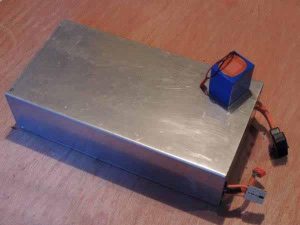“The ultimate low energy vehicle”
(Paper presented to Ontario Science Expo Youth Group, Nov 2013)
For the past four years I have been working on what I consider to be the ultimate vehicle…the lightest electric bicycle on the market.
But rather than dwell on technical details, I would like to (1) give you an overview of what I see as the importance of this technology; and (2) use this as a case history to reflect on what motivates science & innovation.
(1) First, I want to get you thinking about energy:
- Let’s say you own a Honda Civic, a good economical car.
- Let’s say you live 10 km from school.
- Imagine getting up in the morning & pushing that car to school.
- Of course, no-one would do that, but visualizing it helps to understand just how much energy/effort is involved.
- Gasoline is concentrated energy…it would take about half a litre, so about 1 litre for the round trip.
- Now suppose you electrify that car (as I did back in 2006 with a Prius hybrid).
- In Figure 1 you can see one of the three batteries I retrofit into the Prius, each weighing 40 kg and each having just enough storage capacity to make that round trip of 20 km. A sizable battery!
- Cars are heavy. What happens if we don’t carry around that extra 1500 kg?
- How big a battery would it take to make the trip on our electric bike?
- Figure 2 shows the battery that will do that (the little blue one) …it fits in the palm of your hand & weighs less than 1 kg.
- But you say…let’s forget about gasoline or batteries, let’s just pedal the bike and forget about wasting energy.
- However, “human energy” requires food, and making & transporting our food takes a lot of energy…it comes as a surprise to most people to learn that in a total energy audit: Pedaling uses more primary energy than an e-bike (“The energy cost of electric and human-powered bicycles”, Justin Lemire-Elmore 81781999, April 13, 2004), and…
- Walking uses about 1.8x the energy required by the e-bike.

Figure 1: Retrofit battery in Toyota Prius

Figure 2: Compare battery sizes for same range (car vs bike), little blue battery is Pedal Easy standard battery, big aluminum case is 1 of 3 batteries in electric car
(2) Some facts & figures about electric bikes worldwide
- The most efficient means of transport ever devised
- E-bike 10 W.h/km
- Walk 18
- Train 35
- Car (single driver) 400
- 200 million e-bikes in China
-Compare 60 million cars in China
-Worldwide 1000 million cars
- 2012 annual e-bike sales in China 30 million,
- Europe 740,000, Japan 350,000, USA 80,000
- E-bikes are the world’s fastest selling electric vehicle
- Expected to hit 47 million per year by 2018
(3) Our e-bikes
- They are light & sporty, fun, & are designed to encourage people to get out & ride…further & more often than they ever thought they would.
- They are aimed at promoting fitness by harnessing the inherent joy of open-air cycling while allowing the rider to take the peaks off the heavy grunt work.
- A fusion of fun and fitness that “lures you in” to energy-efficient transportation!
- Our bikes are the integration of a high-performance bicycle, high efficiency geared DC motor & state-of-the-art lithium-Ion batteries.
- For people recovering from or living with physical limitations there is an optional control system that allows the rider to program the e-bike to provide feedback on his/her own power & energy expenditure & log the results, as well as allow him to set thresholds & limits for the motor, specific to his own needs:
-For example, a rider with knee problems can set a limit on torque, whereas
-Or a heart rehabilitation patient can set a threshold based on cardiac output (human energy), above which the motor assists.
(4) Reflections on what motivates discovery & innovation
- I have had a passion for designing and improving equipment all my life.
- You may have heard it said that necessity is the “mother” of invention
- If that’s true… then surely play has got to be the “father”
- Looking inwards, I see this clearly…sure, in this case I had a need. I have a heart problem and I wanted to continue riding a bike.
- But the motivation to develop a bike that would meet my needs came from “play” …the “what if”, the wonder, the joy of discovery.
- Looking outwards I wonder. Could it be that play, and fun, are the motivators for most human endeavors, innovation, and discovery?
- Whether it is science, engineering, or the arts, I believe that is true.
- As an old person to a young person, I will leave you with that thought.


